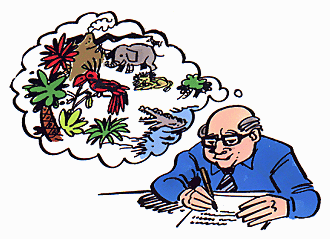Grapho- Words Meaning Write, Record: “tachograph” to “zoography”,
Part 11 of 11.
Words that include: grapho-, graph-, -graph, -graphy,
-grapher, -graphia
(Greek: to scratch; write, record, draw, describe).

tachograph:
A tachometer designed to provide a continuous record of speed or rate.
tachography:
The recording of speed or rate.
tachygrapher:
An ancient Greek or Roman shorthand writer.
tachygraphy, tachygraph, tachygraphic, tachygraphical:
1. The name of ancient Greek and Roman shorthand systems; literally, “fast or speed writing”.
2. Cursive writing.
3. The art or practice of quick writing; variously applied to shorthand, and (in paleography) to cursive as distinguished from angular letters, to the Egyptian hieratic, and to the Greek and Latin writing of the Middle Ages with its many abbreviations and compendia.
technography:
A system that enables a specialized field to perform its function; such as, phonetic transcription, chemical notation, cartography, or computer coding.
telautography, telautograph, telautographic:
The transmission of writing or drawing such that the movements of the receiving pen copy those of the transmitting pen or pencil, yielding a facsimile reproduction at the receiving end. Also: telechirography.
telegraph, telegraphic:
1. An apparatus for transmitting messages to a distance, usually by signs of some kind. Devices for this purpose have been in use from ancient times, but the name was first applied to that invented by Chappe in France in 1792, consisting of an upright post with movable arms, the signals being made by various positions of the arms according to a pre-arranged code. Hence applied to various other devices subsequently used, operating by movable disks, shutters, etc., flashes of light, movements in a column of liquid, sounds of bells, horns, etc., or other means. (Now rare in this sense, such contrivances being usually called semaphores or signalling apparatus).
2. In full, electric (or magnetic) telegraph: An apparatus consisting of a transmitting instrument (transmitter), a receiving instrument (receiver), and a line or wire of any length connecting these, along which an electric current from a battery or other source passes, the circuit being made and broken by working the transmitter, so as to produce movements, as of a needle or pointer, in the receiver, which indicate letters, etc., either according to a code of signs, or by pointing to characters upon a dial. In some forms the receiver works so as to print or trace the message upon a prepared strip of paper.
telegrapher:
One who telegraphs a message or news; the sender of a telegram.
telegraphy:
The art or science of constructing or using telegraphs; the working of a telegraph or telegraphs.
telephotography, telephotograph, telephotographic:
The reproduction of pictures or scenes at a distance by means of an electric current as in the telegraph and telephone; telephoty; phototelegraphy.
thalassography, thalassograph:
The branch of physical geography that deals with the sea, its configuration and phenomena; oceanography.
thanatography, thanatograph, thanatographic:
1. An account of a person’s death.
2. A description of one’s symptoms and thought while dying.
topography, tomograph, tomographic:
1. The science or practice of describing a particular place, city, town, manor, parish, or tract of land; the accurate and detailed delineation and description of any locality.
2. The written features of a region or locality collectively.
3. In anatomy, the description of any part of the body, especially in relation to a definite and limited area of the surface.
trigraph:
A combination of three letters denoting a simple sound.
typography, typograph, typographic:
The action or process of printing; especially, the setting and arrangement of types and printing from them; typographical execution; hence, the arrangement and appearance of printed matter.
ultrasonograph:
A computerized instrument used to create an image using ultrasound. Also: sonograph.
ultrasonography:
1. A technique that makes use of echoes of ultrasound pulses to delineate objects or areas of different density within the body, especially, for diagnostic purposes.
2. The location, measurement, or delineation of deep structures by measuring the reflection or transmission of high frequency or ultrasonic waves. Computer calculation of the distance to the sound-reflecting or absorbing surface plus the known orientation of the sound beam gives a two-dimensional image. Also: sonography.
urography:
Radiography of any part (kidneys, ureters, or bladder) of the urinary tract.
xerography, xerograph, xerographic:
A dry copying process in which an electrically charged surface retains both the charge and a pigmented powder on areas not illuminated by light from bright parts of the document, so that a permanent copy may be immediately obtained by placing paper on the surface and applying heat to fuse the powder to it; photocopying.
xeroradiography:
Radiography using a specially coated charged plate instead of x-ray film, developing with a dry powder rather than liquid chemicals, and transferring the powder image onto paper for a permanent record; edge enhancement is inherent. Also: xerography.
xylograph:
A wood-engraving (i.e. either an engraving on wood, or an impression from one), especially one from an early period.
xylography:
Wood-engraving, especially of an early period or of a primitive kind; also, more widely, printing from wood blocks as distinct from type.
zoogeographer:
A specialist in the study of the distribution of animals on the earth’s surface.

zoogeography, zoogeograph, zoogeographic:
1. A written description of the geographical distribution of animals.
2. The study of the distribution of animals on the earth’s surface.
zoographer:
1. One who describes animals; a descriptive zoologist.
2. A painter or depicter of animals;.
zoography, zoograph, zoographic:
1. Description of animals; descriptive zoology.
2. The art of depicting animals.